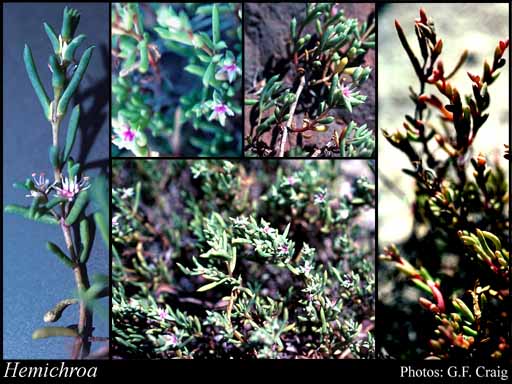- Reference
- Prodr.Fl.Nov.Holland. 409 (1810)
- Name Status
- Current

Scientific Description
Family Amaranthaceae.
Habit and leaf form. Shrubs, or herbs. Plants succulent. Herbs perennial. Leaves cauline. Plants with neither basal nor terminal concentrations of leaves. Halophytic, in coastal salt-marshes and around inland salt lakes. Leaves alternate to opposite (at least the lowermost usually alternate); not decurrent on the stems; fleshy; sessile; non-sheathing; simple. Leaf blades entire; solid; linear to ovate (mucronate); one-veined. Leaves without stipules. Stem anatomy. Nodes unilacunar. Secondary thickening developing from a conventional cambial ring, or anomalous.
Reproductive type, pollination. Fertile flowers hermaphrodite. Unisexual flowers absent. Plants hermaphrodite.
Inflorescence and flower features. Flowers solitary; axillary; 1 per axil; sessile; ebracteate (i.e. subtended by leaves); bi- bracteolate. Bracteoles persistent (scarious, rigid). Flowers minute to small; regular; cyclic; tricyclic. Free hypanthium absent. Hypogynous disk absent. Perianth sepaline (dry and membranous); 5; 1 -whorled; free; petaloid; white; non-fleshy; persistent; non-accrescent. Calyx present (the perianth being thus interpreted); 5; 1 -whorled; polysepalous; erect; imbricate; regular; white; non-fleshy; persistent; non-accrescent; with the median member posterior. Sepals narrowly oblong. Corolla absent. Androecial members definite in number. Androecium 2, or 5. Androecial sequence not determinable. Androecial members free of the perianth; all equal, or markedly unequal; coherent; 1 - adelphous (the filaments basally connate into a short cup); 1 -whorled. Androecium exclusively of fertile stamens. Stamens 2 (the adaxial members), or 5; reduced in number relative to the adjacent perianth (H. diandra), or isomerous with the perianth; oppositisepalous. Anthers dorsifixed; dehiscing via longitudinal slits; introrse; bisporangiate, or tetrasporangiate. Pollen shed as single grains. Gynoecium 2–3 carpelled. The pistil 1 celled. Carpels reduced in number relative to the perianth. Gynoecium syncarpous; synstylovarious; superior. Ovary unilocular; 1 locular. Ovary summit glabrous. Gynoecium stylate. Styles 1; forked; attenuate from the ovary; apical. Stigmas 2; dry type; papillate; Group II type. Placentation basal. Ovules in the single cavity 1; non-arillate; campylotropous.
Fruit and seed features. Fruit fleshy, or non-fleshy; indehiscent; capsular-indehiscent (a utricle); 1 celled; 1 locular; 1 seeded. Seeds non-endospermic. Perisperm present (abundant, mealy). Seeds with starch. Embryo well differentiated. Cotyledons 2. Embryo curved. Testa smooth.
Geography, cytology, number of species. Native of Australia. Endemic to Australia. A genus of 3 species; 2 species in Western Australia.
Additional comments. This succulent genus is usually referred to Chenopodiaceae.
Taxonomic Literature
- Grieve, B. J.; Blackall, W. E. 1998. How to know Western Australian wildflowers : a key to the flora of the extratropical regions of Western Australia. Part II, Dicotyledons (Amaranthaceae to Lythraceae). University of W.A. Press.. Nedlands, W.A..
- Wheeler, J. R.; Rye, B. L.; Koch, B. L.; Wilson, A. J. G.; Western Australian Herbarium 1992. Flora of the Kimberley region. Western Australian Herbarium.. Como, W.A..
- Marchant, N. G.; Wheeler, J. R.; Rye, B. L.; Bennett, E. M.; Lander, N. S.; Macfarlane, T. D.; Western Australian Herbarium 1987. Flora of the Perth region. Part one. Western Australian Herbarium.. [Perth]..